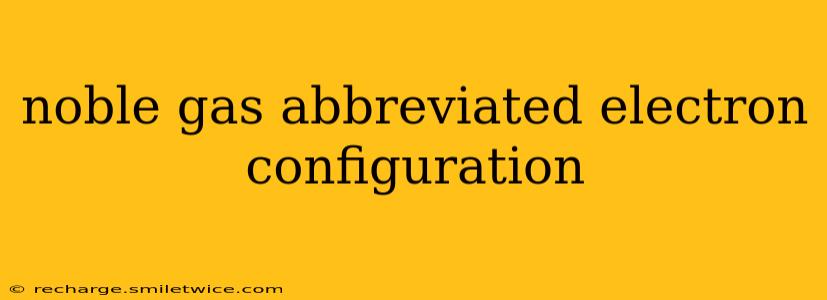Noble gases, also known as inert gases, are a unique group of elements found in Group 18 of the periodic table. Their defining characteristic is their exceptional stability, stemming from their complete valence electron shells. This stability significantly impacts their chemical behavior, making them largely unreactive. Understanding their electron configurations, especially using the noble gas abbreviation method, is crucial for grasping their properties and position within the broader context of chemistry.
This guide will delve into the intricacies of noble gas abbreviated electron configurations, explaining the method, providing examples, and answering common questions.
What is a Noble Gas Abbreviated Electron Configuration?
A noble gas abbreviated electron configuration, also known as a condensed electron configuration, simplifies the representation of an element's electron arrangement. Instead of listing all the electrons in their respective orbitals, it uses the symbol of the nearest preceding noble gas in the periodic table as a shorthand for the core electrons. This significantly reduces the length and complexity of the electron configuration, making it easier to understand and compare.
How to Write a Noble Gas Abbreviated Electron Configuration
The process involves these steps:
- Locate the element on the periodic table.
- Identify the noble gas that precedes the element. This is the noble gas located in the row above the element's row.
- Write the noble gas symbol in brackets [ ].
- Write the remaining electron configuration for the element, starting from the orbital following the noble gas's configuration.
For instance, let's consider potassium (K). Its full electron configuration is 1s²2s²2p⁶3s²3p⁶4s¹. The preceding noble gas is Argon (Ar), whose configuration is 1s²2s²2p⁶3s²3p⁶. Therefore, the noble gas abbreviated electron configuration for potassium is [Ar]4s¹.
Examples of Noble Gas Abbreviated Electron Configurations
Let's explore several examples to solidify our understanding:
- Sodium (Na): Full configuration: 1s²2s²2p⁶3s¹; Abbreviated configuration: [Ne]3s¹
- Chlorine (Cl): Full configuration: 1s²2s²2p⁶3s²3p⁵; Abbreviated configuration: [Ne]3s²3p⁵
- Iron (Fe): Full configuration: 1s²2s²2p⁶3s²3p⁶4s²3d⁶; Abbreviated configuration: [Ar]4s²3d⁶
- Bromine (Br): Full configuration: 1s²2s²2p⁶3s²3p⁶4s²3d¹⁰4p⁵; Abbreviated configuration: [Ar]4s²3d¹⁰4p⁵
- Radon (Rn): Full configuration: 1s²2s²2p⁶3s²3p⁶4s²3d¹⁰4p⁶5s²4d¹⁰5p⁶6s²4f¹⁴5d¹⁰6p⁶; Abbreviated configuration: [Rn] (Because it's a noble gas, the abbreviated configuration is simply its own symbol.)
Why Use Noble Gas Abbreviated Electron Configurations?
Using the abbreviated form offers several advantages:
- Simplicity: It's a more concise way to represent the electron configuration, especially for elements with many electrons.
- Clarity: It emphasizes the valence electrons, which are crucial in determining an element's chemical behavior. The valence electrons are the electrons not included in the noble gas notation.
- Comparison: It facilitates easier comparison of electron configurations between different elements, highlighting similarities and differences in their electronic structures.
Frequently Asked Questions
What are the noble gases?
The noble gases are Helium (He), Neon (Ne), Argon (Ar), Krypton (Kr), Xenon (Xe), Radon (Rn), and Oganesson (Og).
Why are noble gases unreactive?
Noble gases have a full valence electron shell (except for Helium, which has a full 1s orbital), making them extremely stable. They have little tendency to gain, lose, or share electrons, resulting in their low reactivity.
Are there exceptions to the noble gas rule of reactivity?
While generally unreactive, some heavier noble gases (like Xenon and Krypton) can form compounds under specific conditions, typically with highly electronegative elements like fluorine and oxygen. These are exceptions, rather than the rule.
How do noble gas configurations relate to ionic bonding?
Many ions achieve a stable noble gas configuration through the gain or loss of electrons. For instance, sodium (Na) loses one electron to achieve a neon configuration (Na⁺), while chlorine (Cl) gains one electron to achieve an argon configuration (Cl⁻). This is a driving force behind ionic bonding.
This comprehensive guide provides a thorough understanding of noble gas abbreviated electron configurations, their significance, and their applications in chemistry. By mastering this concept, you will gain a deeper appreciation for the organization and properties of elements within the periodic table.
